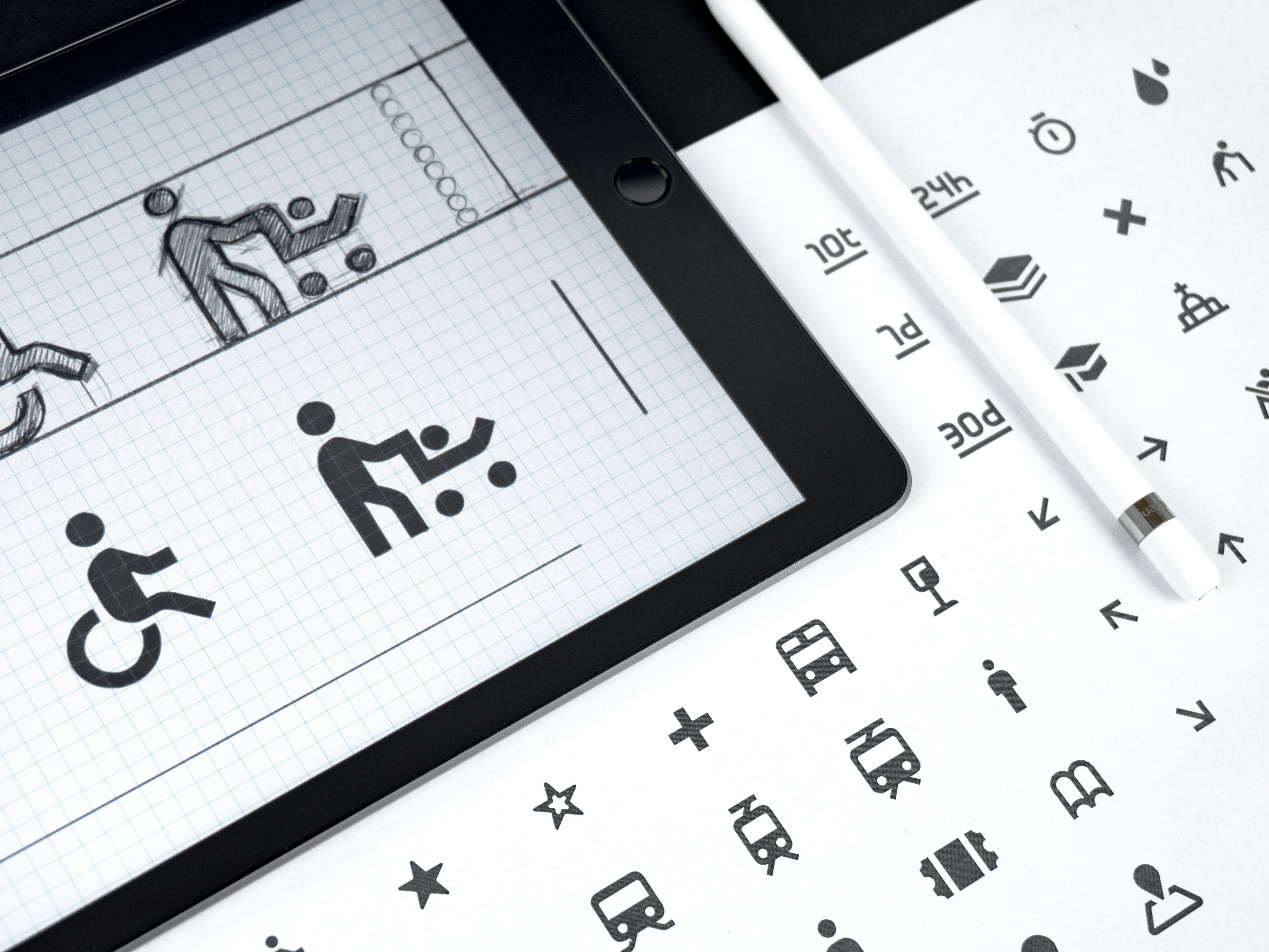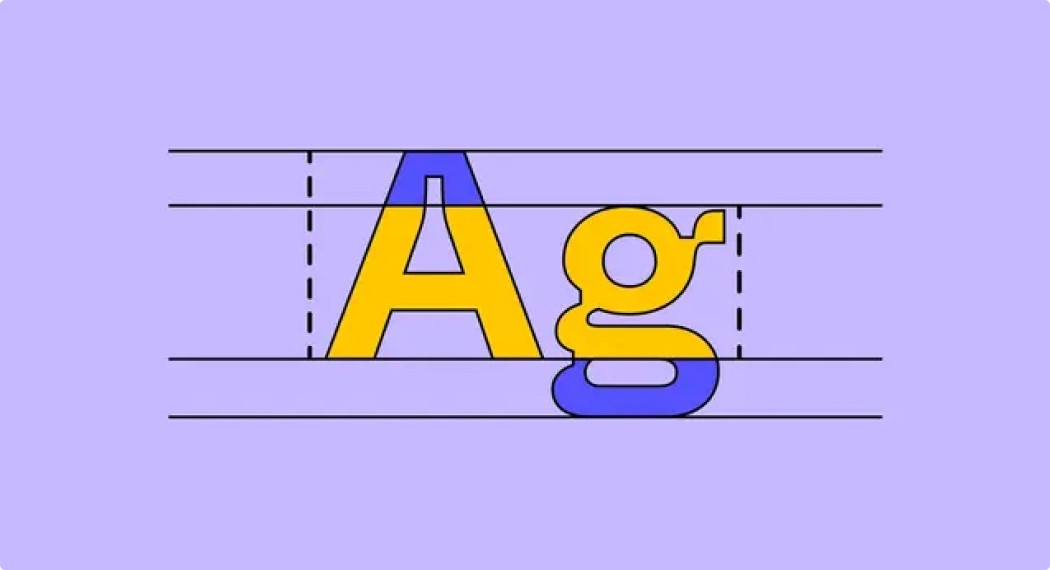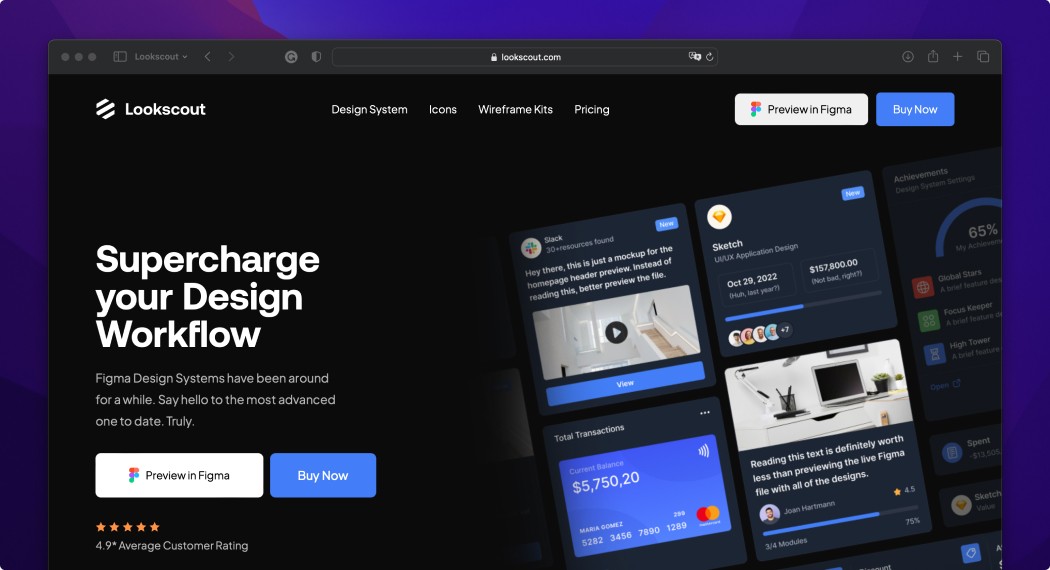The Ultimate Guide to E-Commerce Design in 2023
The success of any ecommerce website design or mobile app depends heavily on providing users with an enjoyable experience. That’s why understanding the main considerations that UI/UX designers need to take into account when creating an e-commerce platform is so important. This article will provide a comprehensive overview of the most essential points that those involved in the design process should keep in mind when building digital storefronts.
Main E-Commerce Considerations
As e-commerce continues to grow as a dominant force in the retail industry, it’s more important than ever for businesses to create a seamless and engaging online shopping experience on their ecommerce website. For UI/UX designers, this means understanding the unique considerations that come with designing for e-commerce. In this article, we’ll explore some key considerations that designers should keep in mind when designing e-commerce websites.
Clear and intuitive navigation
One of the most important considerations for ecommerce website design is clear and intuitive navigation. Customers should be able to easily find what they’re looking for and move through the purchasing process with ease. This means designing a clear and easy-to-use navigation menu, providing breadcrumb navigation for easy backtracking, and creating clear and concise product categories and subcategories.
Search functionality
Search functionality is also key for ecommerce website experiences. Many customers will go straight to the search bar to find what they’re looking for, so it’s important to ensure that the search bar is easy to find and use. Additionally, designers should consider implementing autocomplete functionality to help customers find what they’re looking for more quickly.
Visual design
Visual design is another crucial consideration for e-commerce websites. The design should be clean and modern, with a focus on high-quality product images and clear typography. The overall aesthetic should be consistent throughout the website, creating a cohesive brand experience.
Mobile responsiveness
With the rise of mobile devices, it’s more important than ever for e-commerce websites to be mobile responsive. This means designing for smaller screens and ensuring that the website is optimized for touch-based interactions. Additionally, designers should consider implementing mobile-specific features such as swipeable galleries and one-click checkout.
User testing
User testing is a critical component of ecommerce website design. By testing the website with real users, designers can gain valuable insights into how customers interact with the website and identify areas for improvement. User testing can include everything from A/B testing different design elements to conducting usability tests with real customers.
Security and trust
Security and trust are major concerns for customers shopping online. To help instill confidence in the website, designers should include clear trust signals such as SSL certificates, security badges, and customer reviews. Additionally, designers should ensure that the checkout process is secure and that customers feel confident entering their payment information.
Personalization
Finally, personalization is becoming increasingly important in ecommerce website design. By creating personalized experiences for customers, businesses can increase engagement and loyalty. This can include everything from personalized product recommendations to targeted email campaigns based on customer behavior.
Designing ecommerce website and platforms requires a unique set of considerations for UI/UX designers. From clear and intuitive navigation to mobile responsiveness and personalized experiences, designers must consider the entire customer journey when creating an engaging and seamless e-commerce experience. By focusing on these key considerations, designers can create websites that not only meet customer needs but also drive business success.
User Experience
User experience (UX) is one of the primary components that needs to be taken into consideration when designing an ecommerce website. This includes everything from ensuring ease of navigation to ensuring fast loading speeds and optimizing for mobile devices. UX designers must ensure that users can quickly find what they are looking for and easily purchase items without any complications. It’s also important to make sure that visitors are shown products they might be interested in based on their past purchases or search history, which requires developing personalized product recommendations.
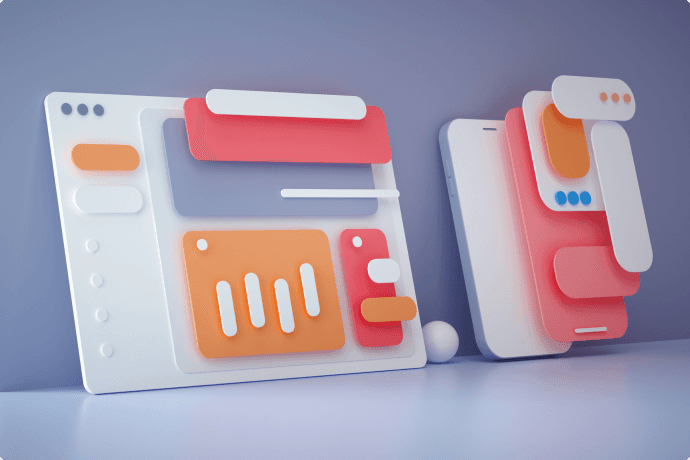
Key Principles for User Experience in E-Commerce Design
User experience (UX) is one of the most important aspects of ecommerce design website. E-commerce websites are designed to provide a platform for customers to shop online and buy products or services, and the user experience plays a critical role in how successful these sites are. A positive user experience can encourage customers to purchase products, while a negative user experience can drive them away. Here are some key user experience aspects that designers should consider when designing e-commerce websites:
Easy navigation: Navigation is a crucial part of the user experience. Designers should ensure that the website's navigation is easy to use, intuitive, and clear. Customers should be able to find what they are looking for quickly and easily.
Simple checkout process: The checkout process is where customers make the final decision to purchase a product. A complicated checkout process can frustrate customers and drive them away. Designers should ensure that the checkout process is simple and easy to follow, with clear instructions and minimal steps.
Product images: High-quality product images are essential for e-commerce websites. Customers want to see what they are buying, and high-quality images can help them make purchasing decisions. Designers should ensure that the product images are clear, well-lit, and visually appealing.
Product information: In addition to images, customers need information about the products they are considering purchasing. Designers should ensure that the product information is clear, concise, and easy to understand. This information should include product features, specifications, and any other relevant details.
Responsive design: With more and more people accessing e-commerce websites from mobile devices, designers should ensure that the website is optimized for all devices, including desktops, laptops, tablets, and smartphones. The website should be responsive, meaning that it should adapt to the device's screen size and resolution.
Loading speed: Slow loading times can frustrate customers and drive them away. Designers should ensure that the website loads quickly, with minimal lag time.
Trust signals: Trust signals, such as customer reviews and security badges, can help build trust with customers. Designers should ensure that trust signals are visible and prominently displayed.
Personalization: Personalization can help make the user experience more engaging and relevant. Designers should consider implementing personalized recommendations and personalized content to help customers find what they are looking for more easily.
Ecommerce website design should consider the user experience as a critical component of their designs. By focusing on easy navigation, a simple checkout process, high-quality product images and information, responsive design, fast loading times, trust signals, and personalization, designers can create engaging and successful e-commerce websites.
User Interface
When it comes to user interface (UI), there are several elements that can help make the shopping process more engaging and intuitive for customers. These include visuals such as high quality photos or videos, cleverly placed promotions, easy payment options, and social media integration. UI also has a role to play when it comes to organizing content on the website in a way that makes sense to users such as grouping similar items together or including descriptions and reviews alongside each product listing. In addition, having an aesthetically pleasing design with consistent branding across all pages will help create a lasting impression on customers.

Key Principles for User Interface in E-Commerce Design
Consistency: Designers should ensure that the website's design elements, such as colors, fonts, and buttons, are consistent throughout the website. This creates a cohesive and easy-to-use interface.
Clear and concise typography: Typography is an essential element of any UI designs, and ecommerce websites are no exception. Designers should use clear and concise typography that is easy to read. This includes using appropriate font sizes, spacing, and line height.
Color scheme: A well-chosen color scheme can create a positive user experience. Designers should use colors that are visually appealing and help create a clear hierarchy of information.
Buttons: Buttons are one of the most important elements of UI design. They should be clear, visually prominent, and easy to use. This includes ensuring that buttons are large enough to be clicked on easily and that they have clear labels.
Product images: High-quality product images are a critical component of ecommerce website design. They should be large, visually appealing, and optimized for fast loading times.
Search bar: The search bar is an essential UI element in ecommerce website design. It should be easy to find and use, with autocomplete functionality to help customers find what they are looking for quickly.
Responsive design: With more and more people accessing ecommerce websites from mobile devices, designers should ensure that the website is optimized for all devices, including desktops, laptops, tablets, and smartphones. The website should be responsive, meaning that it should adapt to the device's screen size and resolution.
Feedback and error messages: Feedback and error messages are essential in ecommerce site design. They should be clear and concise, providing customers with the information they need to complete their purchase successfully.
Calls-to-action: Calls-to-action (CTAs) are critical in ecommerce site design. They should be visually prominent and easy to use, guiding customers through the purchasing process.
Checkout Process
The checkout process is one of the most critical stages when it comes to designing an e-commerce platform or ecommerce site so it’s important for designers to reduce any possible friction points along this part of the journey for users. One way to do this is by including progress bars throughout the purchasing process so people know exactly where they are in terms of remaining steps until completion; another way would be allowing people to save payment methods if they decide not complete their purchase but wish return later without needing reenter their information multiple times every time they visit your store again. Finally setting up secure payments via trusted names like PayPal and Stripe will help build trust with customers as well show them you take security seriously which can ultimately lead better conversion rates down the line.

Key Principles for the Checkout Process
The checkout process is one of the most important aspects of ecommerce website UI/UX design. It's the stage where customers make the final decision to purchase a product, and a smooth and easy-to-use checkout process can encourage customers to complete their purchase. Here are some key considerations for designers when designing the checkout process:
Keep it simple: The checkout process should be simple and easy to follow. Customers should be able to complete the process in as few steps as possible. Keep the number of form fields to a minimum, and only ask for essential information.
Clear instructions: Provide clear instructions throughout the checkout process. This includes providing instructions on how to fill out form fields, how to select payment options, and how to complete the purchase.
Guest checkout option: Provide a guest checkout option for customers who don't want to create an account. This can help reduce friction and make the checkout process faster and easier.
Visual progress indicators: Provide visual progress indicators that show customers where they are in the checkout process. This can help reduce confusion and frustration.
Shipping and billing information: Provide clear options for shipping and billing information. Customers should be able to easily select their shipping and billing addresses, and the checkout process should provide real-time shipping and tax information.
Payment options: Provide multiple payment options to accommodate a range of customer preferences. This can include credit card payments, PayPal, and other payment options.
Security and trust signals: Security and trust signals are essential in the checkout process. Provide clear signals that the checkout process is secure, such as SSL certificates and security badges. Also, include customer reviews and testimonials to help build trust with customers.
Mobile optimization: With more and more customers using mobile devices to shop online, it's essential to optimize the checkout process for mobile devices. This includes using responsive design, optimizing form fields for touch input, and ensuring that the checkout process is fast and easy to use on mobile devices.
Confirmation and thank you page: Provide a clear confirmation page and thank you page after customers complete their purchase. This can help reduce anxiety and provide customers with the information they need to track their purchase.
Designing a smooth and easy-to-use checkout process is essential for e-commerce UI/UX design. By keeping the process simple, providing clear instructions, offering guest checkout, providing visual progress indicators, clear shipping and billing options, multiple payment options, security and trust signals, mobile optimization, and a clear confirmation and thank you page, designers can create an engaging and successful checkout process that encourages customers to complete their purchase.
Trends in E-Commerce Designs in 2024

As we head into 2023, there are several trends emerging in e-commerce design that designers should be aware of. Here are some of the key trends to watch:
Voice commerce
As voice assistants become more common, voice commerce is becoming a trend in e-commerce. Designers should consider implementing voice search functionality and creating voice-first experiences to accommodate customers who prefer to use voice assistants.
Augmented Reality (AR)
Augmented Reality (AR) is a trend that's gaining popularity in e-commerce. AR can help customers visualize products in their own environment, creating a more immersive and engaging shopping experience. Designers should consider implementing AR to help customers make purchasing decisions.
Minimalist design
Minimalist design is becoming more prevalent in e-commerce. With customers increasingly looking for fast and easy shopping experiences, minimalist designs can help streamline the shopping process and create a more seamless user experience.
Microinteractions
Microinteractions are small, subtle interactions that provide feedback to users. They can help create a more engaging and delightful user experience. Designers should consider implementing microinteractions, such as animations and haptic feedback, to enhance the user experience.
Sustainability
As sustainability becomes an increasingly important issue for customers, designers should consider implementing sustainable design principles in e-commerce websites. This can include using eco-friendly materials and designing websites that promote sustainability.
Personalization
Personalization is becoming more important in e-commerce. By creating personalized experiences for customers, businesses can increase engagement and loyalty. Designers should consider implementing personalized product recommendations, targeted email campaigns, and other personalized features to help customers find what they're looking for more easily.
There are several trends emerging in ecommerce website design in 2023, including voice commerce, AR, minimalist design, microinteractions, sustainability, personalization, and mobile optimization.
Top 10 E-Commerce Website Design Examples
Design is subjective, but there are some e-commerce websites that are widely recognized for their visually stunning designs. Here are some of the most beautiful e-commerce website designs:
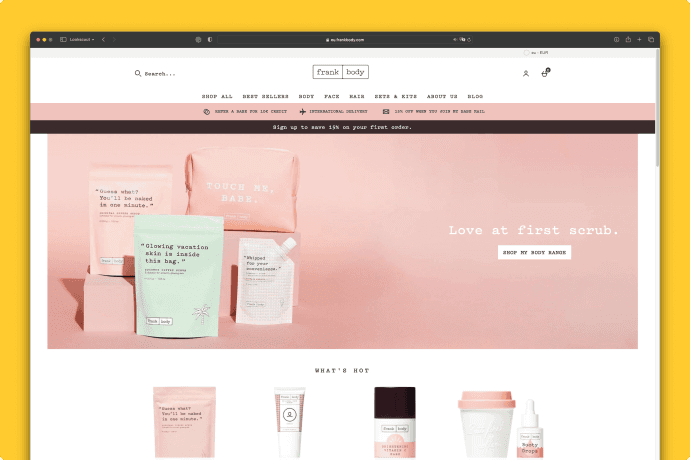
Frank Body
Frank Body is a skincare brand that offers high-quality natural products. Its website features a unique and visually appealing design, with bright colors and playful animations.
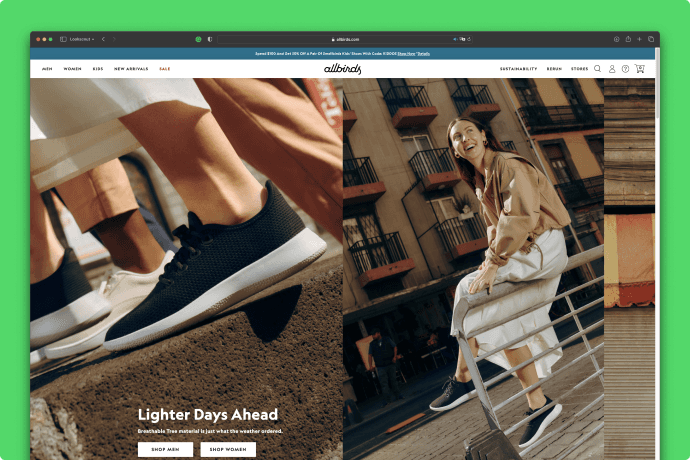
Allbirds
Allbirds is a footwear company that offers sustainable and comfortable shoes. Its website features a minimalist design with high-quality product images and clear calls-to-action.
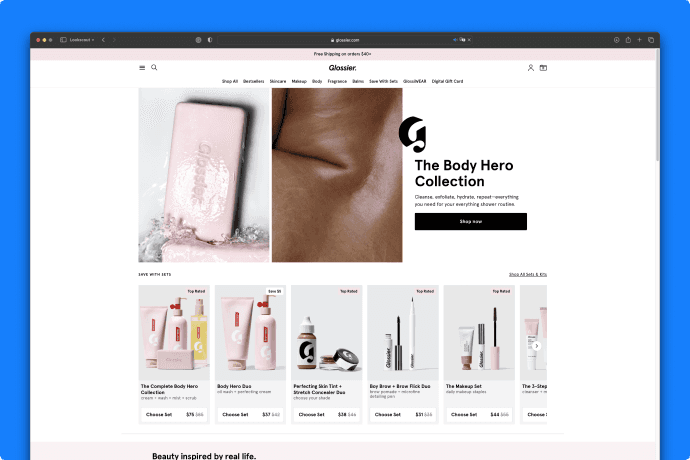
Glossier
Glossier is a popular beauty brand that offers high-quality skincare and makeup products. Its website features a simple and elegant design, with pastel colors and visually appealing product images.
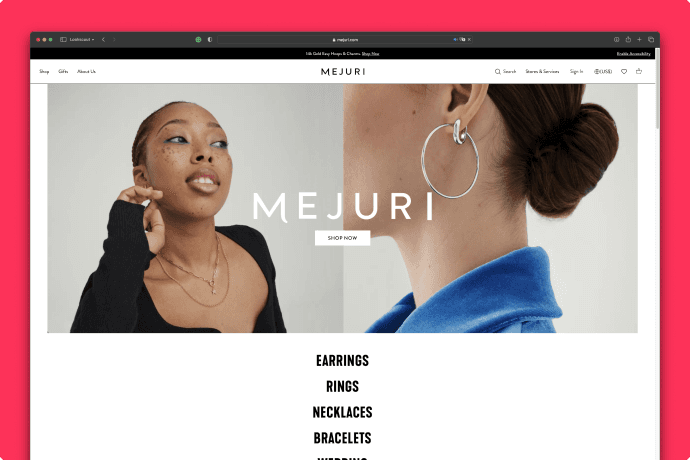
Mejuri
Mejuri is a jewelry brand that offers high-quality and unique pieces. Its website features a minimalist design with elegant typography and high-quality product images.
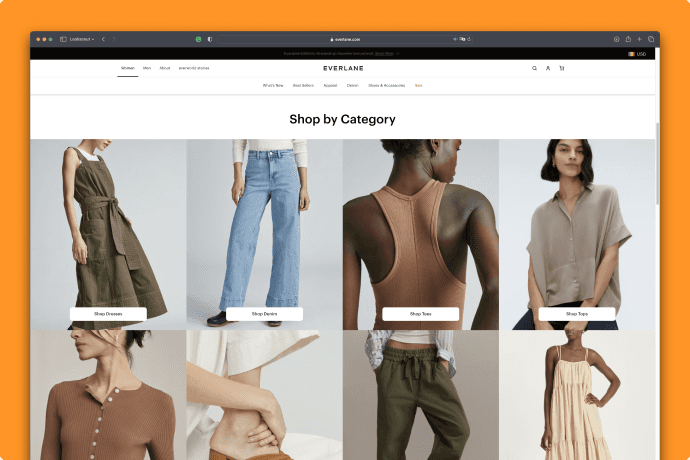
Everlane
Everlane is a clothing brand that offers sustainable and ethically made apparel. Its website features a minimalist design with high-quality product images and clear calls-to-action.

Cuyana
Cuyana is a fashion brand that offers high-quality and sustainable clothing and accessories. Its website features a simple and elegant design, with muted colors and high-quality product images.
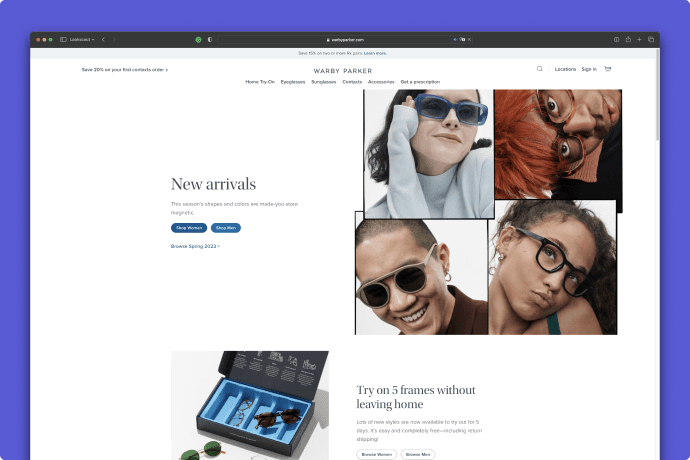
Warby Parker
Warby Parker is a popular eyewear brand that offers affordable and stylish glasses. Its website features a minimalist design with high-quality product images and clear calls-to-action.
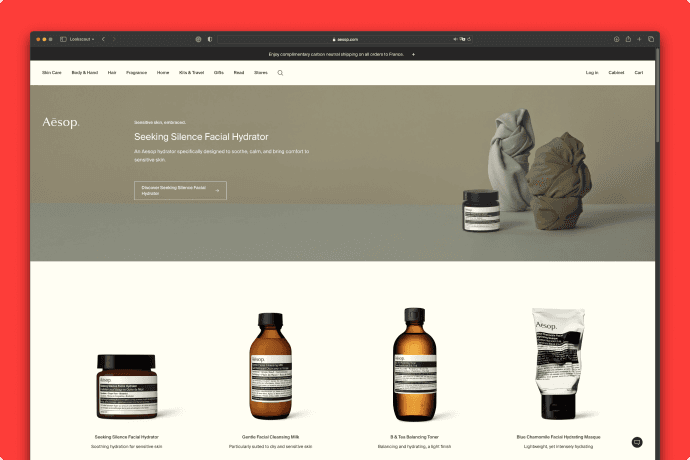
Aesop
Aesop is a skincare brand that offers high-quality and natural products. Its website features a unique and visually appealing design, with minimalist typography and high-quality product images.

Rothy's
Rothy's is a footwear brand that offers sustainable and stylish shoes. Its website features a minimalist design with high-quality product images and clear calls-to-action.
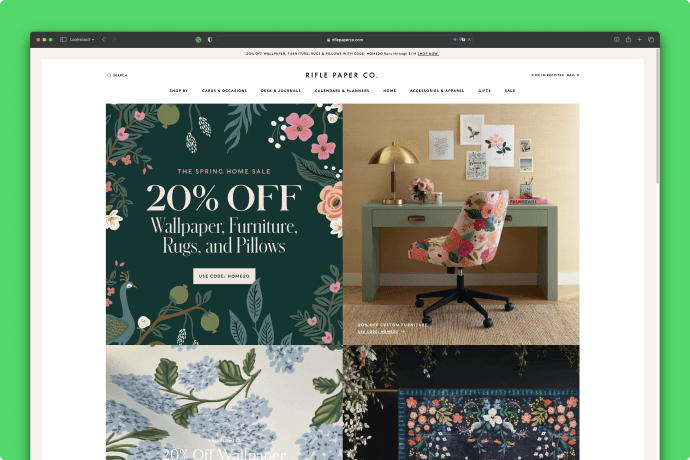
Rifle Paper Co.
Rifle Paper Co. is a stationery and gift brand that offers unique and beautiful products. Its website features a visually appealing design with playful illustrations and bright colors.
These e-commerce websites are known for their visually stunning designs. They feature unique and elegant designs, with high-quality product images and clear calls-to-action. By analyzing these examples, designers can gain valuable insights into what makes a beautiful ecommerce website design.
Wrapping Up
Designing an effective ecommerce website requires considering both UX and UI aspects whilst keeping visual appeal top priority throughout the entire process from product selection till checkout completion – it’s these considerations which allow developers create enticing experiences that captivate audiences efficiently thereby increasing sales over time . By following best practices outlined above , development teams should have little trouble generating profitable results from their projects whilst simultaneously delivering great customer satisfaction levels.

